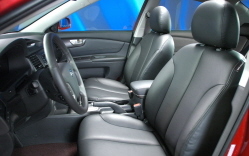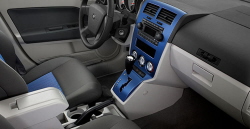Both the press and consumers frequently criticize auto interiors for “looking cheap.” There are two reasons for this. First, manufacturers like Volkswagen and Lexus have raised expectations. Second, in an effort to cut costs manufacturers have been making increasing use of hard plastic.
But all hard plastic is not created equal. Honda uses acres of the stuff in the Accord, but many people still perceive that car’s interior as among the best in its class. Texture, sheen, tight fits, and such help.
And then there’s color.
 In many of my reviews, I’ve suggested that the interior of the car in question looks much higher in quality when dressed in black. Recent examples include the Saturn Outlook and Toyota Camry. And the Kia Optima’s interior (pictured), while it uses higher grade materials than most in the segment, has an especially upscale ambiance in black. (The Kia has been getting a surprising amount of positive press lately; this interior deserves much of the credit.)
In many of my reviews, I’ve suggested that the interior of the car in question looks much higher in quality when dressed in black. Recent examples include the Saturn Outlook and Toyota Camry. And the Kia Optima’s interior (pictured), while it uses higher grade materials than most in the segment, has an especially upscale ambiance in black. (The Kia has been getting a surprising amount of positive press lately; this interior deserves much of the credit.)
 Pity poor Chrysler. Not only does it produce the cheapest interiors, but it offers many of them only in shades of gray. (Good try with the colorful trimplates and seat inserts, but these cannot entirely distract one’s eye from the preponderance of light gray hard plastic.) For a long time GM didn’t offer dark interiors in many cars–just boring beige and light gray–but judging from the Outlook and other recent products it seems to have finally stumbled upon black as a solution.
Pity poor Chrysler. Not only does it produce the cheapest interiors, but it offers many of them only in shades of gray. (Good try with the colorful trimplates and seat inserts, but these cannot entirely distract one’s eye from the preponderance of light gray hard plastic.) For a long time GM didn’t offer dark interiors in many cars–just boring beige and light gray–but judging from the Outlook and other recent products it seems to have finally stumbled upon black as a solution.
Update: While I like a black interior, I don’t mean the interior should be all black. As I’ve written in a more recent blog entry, sometimes you need a little wood.